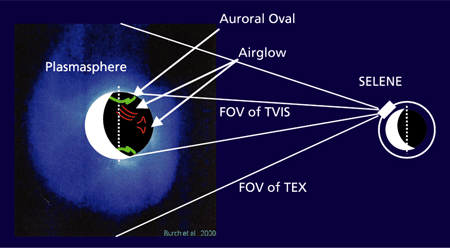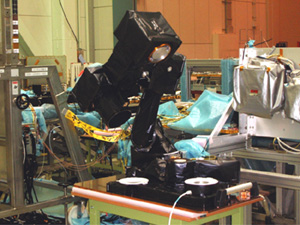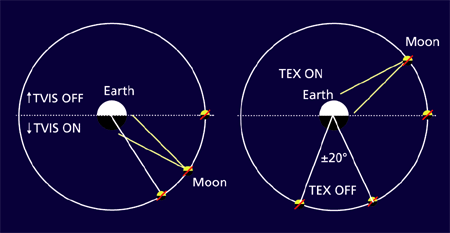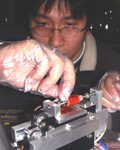From an orbit around the Moon the Upper-atmosphere and Plasma lmager (UPl) will look at the Earth using two telescopes : an extreme ultraviolet telescope(TEX) to observe the plasmasphere and a visible telescope (TVIS) to observe global distribution of aurora and airglow.

TEX detects the resonance scattering emissions of oxygen ion and helium ion. The telescope employs a high-efficiency mirror and micro-channel plates with a resistive anode producing 128x128pixel images. The corresponding spatial resolution is 500km.
TVIS is equipped with a fast catadioptric optics and a high-sensitivity CCD to image swift aurora and dark airglow. TVIS has a field-of-view equivalent to the Earth disk seen from the Moon.Spatial resolution is about 30km on the Earth's surface. Observation wavelengths can be changed by selecting filters.
| UPI-TVIS | UPI-TEX | |
|---|---|---|
| aperture | 136mm(f=320mm) diameter | 120mm(f=168mm) diameter |
| detector | Back-illuminated frame transfer CCD | micro-channel plates with a resistive anode |
| field of view | 2.38 degrees x 2.38 degrees (512 x 512pixel) | 10 degrees x 10 degrees (128 x 128pixel) |
| wavelength | 428nm,558nm,589nm,630nm,>730nm | 30.4nm,83.4nm |

TEX and TVIS are mounted on a special two-axes gimbals mount.The primary and secondary axes cancel the orbital motions of the satellite and the Moon, respectively. Thus, the telescopes can stay pointed to the Earth. UPl is operational only when the satellite is in the lunar shade and visible from the Earth.

From TEX observations we will know the spatial plasma distribution around the Earth every 10 minutes. Especially, imaging of the entire globe by oxygen ion emission will promote the space plasma physics. Using images of the auroral ovals teken by TVIS intensities and shapes of conjugate auroras will be quantitatively compared. By airglow imaging global propagation of large-scale ionospheric disturbances will be clearly seen.

Ichiro Yoshikawa
Department of Earth and Planetary Science,
Graduate School of Science,Tokyo Univ.